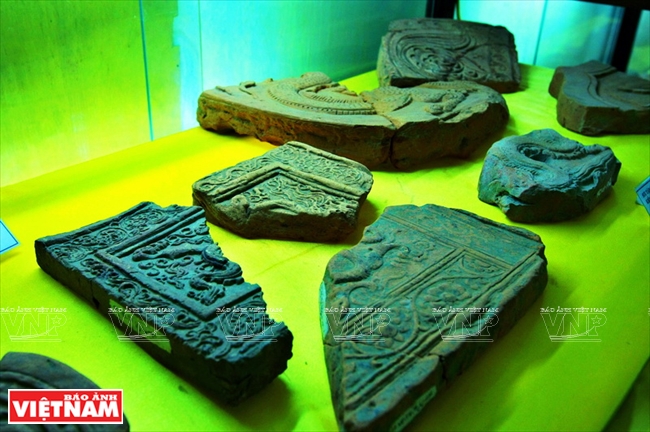| The Ho Dynasty Citadel is a unique architect work made of stone in Vietnam. King Ho Quy Ly ordered the construction of the citadel in the spring of 1397 and named it Tay Do (Tay Giai), or western capital, which made it different from the Dong Do (eastern capital) or Thang Long, Hanoi. The citadel was once an economic, political and cultural centre of the late Tran Dynasty, and capital of the Dai Ngu State for seven years, from 1400 to 1407. |
Many times, I got hurt, and even bloodied my feet, after the game ended. I did not know until years later when I grew up and learnt history at school that over 600 years before, many glorious battles took place at the citadel with lots of the blood of our forefathers defending our country.
At that time, the most interesting pastime of the local children and I was to dig the crickets hidden under the wall around the citadel. However, we did not find any crickets, instead, we found a round stone ball, which was as big as a pomelo. When we showed the stone ball to my grandma, she said: “It’s a stone cartridge of Old Trung!” I imagined that it was a game using a slingshot and that Trung was a super strong genie who could shoot such a big stone cartridge.
|
The Ho Dynasty citadel’s four gates face South, North, West and East, called Front, Back, Left and Right, respectively. The gates are built in the form of domes, with stone slabs set as pomelo sections and each slab is 7m long, 1.5m high, and about 15 tonnes. In the photo is the Front Gate, which consists of three domes, 33.8m long, 9.5m high and 15.17m wide. Photo: Thong Thien The entire outside citadel walls are grafted with green stone slabs, piled one on top of the other tightly, some slabs are 6m long and over 20tons. According to scientists’ calculation, the total amount of stones used in building the Ho Dynasty Citadel is about 20,000m3. Photo: Cong Dat According to the assessment by CNN’s online Travel website, the Ho Dynasty Citadel was awarded the “Honour Title” by UNESCO for two reasons. First, the Ho Dynasty existed only for seven years (1400-1407) in a period full of upheavals in Vietnamese history. Second, the Ho Dynasty Citadel is “an outstanding model for a new style of a South-east Asian capital”. In 2015, CNN classified the Ho Dynasty as “one of the world’s 21 most outstanding and greatest heritages”. Photo: Thong Thien The outside citadel walls are built with green stone slabs, which are carved and crafted skillfully, the biggest one about 26tons. Big stone slabs are mostly seen at the western, southern and eastern walls. Photo: Cong Dat According to evaluations by scientists and historians, the Ho Dynasty Citadel’s four main gates are built logically, with stone slabs carved in square and set in the form of pomelo sections to resist big shakes, including earthquakes. Between stone slabs, there is not any glue, but the citadel has remained intact for over 600 years through seismic shakes and bombings. Photo: Cong Dat 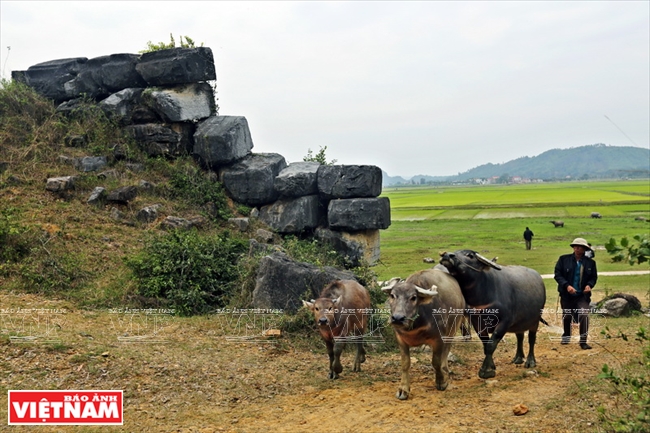 The citadel’s inside walls are ramparts made of clay, sand and pebbles, which are rammed down carefully in layers. The ramparts slope towards the inner citadel, and are about 60-70cm thick. Photo: Thong Thien The royal citadel is built on an area which is almost square, with the north-south length of 870.5m and the east-west length of 883.5m. The Hoa Nhai (royal) path, built in August 1402 and paved with stone slabs, is about 2.5km long leading to the Nam Giao Altar (where the king worships). Photo: Cong Dat A CNN reporter described his job when working at the Ho Dynasty Citadel: “Part of the citadel walls got sunk or covered by plants – it’s unavoidable, but that created some mysterious relics. Around the citadel are corn or rice fields, and a long path, all seemingly unaffected by time…” Photo: Cong Dat According to old records, the main path axis in the southern gate of the citadel is called Cai Hoa, Hoa Nhai or Hoe Nhai. In a recent archaeological excavation in this area, there were imprints of an ancient path running from the inside of the citadel through the southern gate to Don Son mountain. Photo: Cong Dat Thanh Hoa Province People’s Committee wants the local tourism activities to include tours to bring visitors to the Ho Dynasty Citadel to highlight the value of this world’s heritage. Photo: Cong Dat |
Through books, I learned that Old Trung was a historical figure from the Ho Dynasty, named Ho Nguyen Trung (1374-1446), an architect of the huge stone citadel. The stone ball we found was one of the cartridges used for the cannons to shoot the invaders. At that time, the cannon was a new type of weapon.
The mystery for me is about a couple of stone dragons without heads, discovered by the local farmers when they dug the moats inside the citadel. The headless dragons were moved to sit on the main road linking the Front Gate to the Back Gate. When I asked my grandma about the dragons, she said they were of Ho Quy Ly, and as they are sacred dragons we children should not climb on them or draw silly paintings on them!
My grandma also recalled a story of the local people in Tay Giai Hamlet saying that the locality used to have many fires. A person familiar with feng shui passed by the hamlet, saying that the fires were caused by the dragons because they stood facing the hamlet. After his declaration, the dragons had no heads at all! In the mind of a five-year-old boy, I thought Ho Quy Ly was such a mighty genie that he could ride a stone dragon breathing fires that damaged houses.
At school, from history lessons, I also got to know that Ho Quy Ly (1336-1407) was the founder of the Dai Ngu feudal state. As king, he ordered the construction of the stone citadel, along with implementing many progressive reforms which have been recognised by the world. In history, there are many legends mentioning the headless stone dragons. One legend goes that after the Ming invaded our country, they cut off the stone dragons’ heads, while another one says that because the dragons’ eyes were made with valuable gems, they were stolen after the heads were cut off.
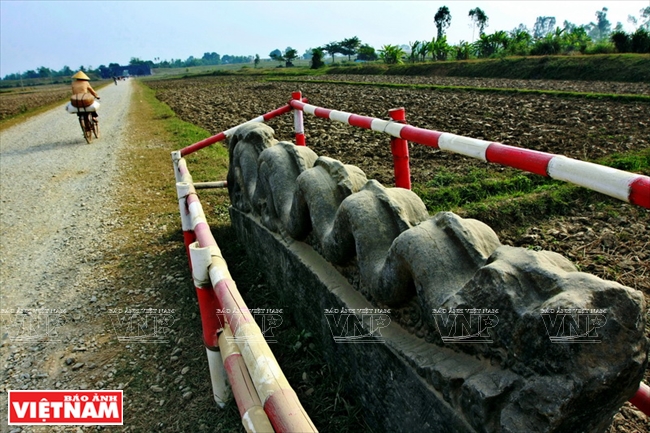 Pham Van Dau (from Thanh Hoa Province’s Historians Association) assessed that the couple of stone dragons at the Ho Dynasty Citadel are among the most beautiful and biggest stone statues in Vietnam to date. They reflect the art of carving in the Tran Dynasty during its thriving period, which described the dragons’ characteristics, as robust and full. Photo: Thong Thien 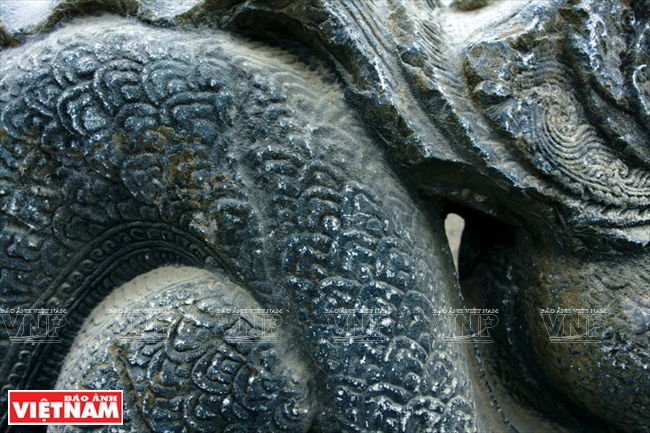 The pair of stone dragons is carved carefully, with their bodies smaller down at their tails, curving into seven sections, and entirely covered with scales. The dragon has four feet, each with three nails with soft, falling feathers. The head is no longer seen, but its long mane goes up and down into nine layers. Photo: Cong Dat 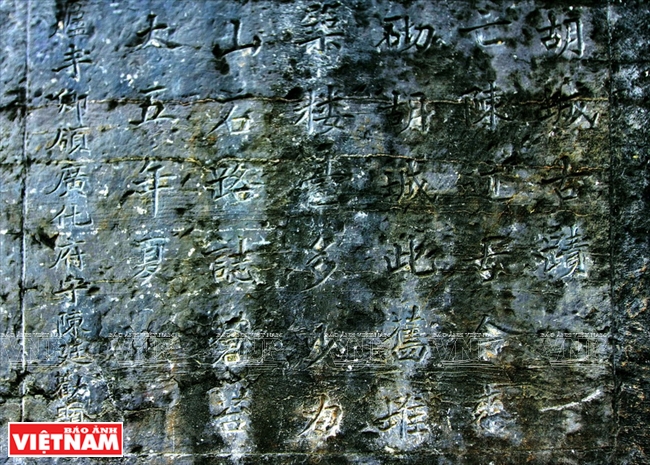 At the western gate, there remains relics of a poem in Han characters engraved in the form of seven words-eight sentences by district chief Nguyen Dao, who composed it in the spring of Qui Dau (Year of the Rooster) under King Bao Dai (1923). The poem praises the natural scenery around the Ho Dynasty’s stone citadel. Photo: CongDat
|
That day, Ngoc, a friend of mine, and I had an argument with Tay Giai local people about how the stone citadel was built. I said, Ho Quy Ly, the man who rode the stone dragon breathing fire on the hamlet, was the one who carved the huge stone slabs and piled them up into the citadel. Meanwhile, Ngoc said, he saw how the quarrymen worked, and so there had to be many people to chisel rocks from the Vang mountain (in Vinh Loc district) into square slabs, but he truly did not know how they shaped them into the citadel. Ngoc even promised us that he would find out the answer when he grew up.
Children from Tay Giai hamlet grew up and each followed their own path to earning a living, but there was no one who became a historian in order to decode their childhood mysteries.
From 2013 to 2020, Thanh Hoa province invested over 90 billion VND (roughly 391,000 US dollars) in implementing the project to excavate the Ho Dynasty Citadel, a World Heritage. It is the biggest excavation conducted at this historical site. The excavation work is conducted in an area of 56,000m2; 25,000m2 on the inner palace, 12,000m2 on the moats, 5,000m2 on the citadel gates, and 14,000m2 on the royal path.

